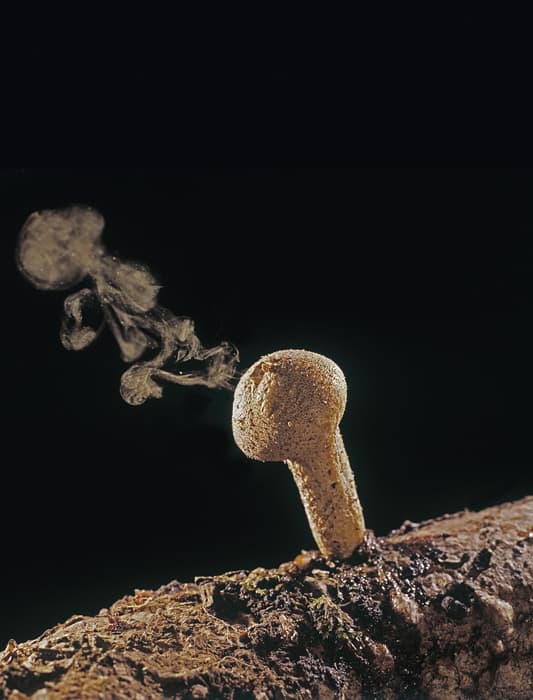Photo Insight with Heather Angel
 An internationally renowned photographer of the natural world and author of more than 50 books, Heather brings her expertise to AP
An internationally renowned photographer of the natural world and author of more than 50 books, Heather brings her expertise to AP
Walking through a woodland area is truly one of the most magical things you can do as a photographer. The things you can find there are extraordinary, and when you’re able to accurately represent them through the lens of your camera you’re left with unique and fascinating shots. The image here is one such example. There have been a handful of occasions when I’ve been scouting for images in a forest and witnessed the effect you see in this photograph, but it has always been far too quick for me to capture.
The unusual object in the frame is a puffball fungus on top of a log. The cloud you see emanating from the hole is a cluster of spores. Unlike plants, fungi don’t have seeds. Instead, they have spores, so that means the fungi need a means of dispersing those spores to create more fungi. What normally happens is that when rain falls, the slight pressure of raindrops on the surface of the fungus causes the pod to evacuate its spores, shooting them into the air. Animals running around in the forest and knocking the fungi have the same effect. The spores are microscopic, yet there are so many that they form a cloud. Now obviously not all spores succeed, which is just as well because otherwise we’d be knee-deep in puffballs!
As well as relying on the spores to be picked up in the breeze and carried away, some will become attached to the legs of small mammals and insects as they move around the ground. They will then transport the spores to other areas of the forest. It’s all about attempting to transport the spores away from the parent fungus and spreading them across the environment.
This particular shot was actually taken in a studio environment. I managed to collect the log with the puffball intact. Had I removed the fungus from the log it wouldn’t have looked quite as good and I probably would have ended up ruining it. Being able to photograph the fungus in the studio environment meant I had total control over what happened and I could carefully arrange the lighting and background, which in this case is black. I think the black backdrop really helps to show the fungus and its spores to best effect.

Had I taken this shot in the natural environment, I would have had to contend with a mixture of twigs and leaves cluttering up the background. Crucially, that would have meant losing much of the detail of the spore cloud.
I should point out as a side note that not removing the fungus from the log also meant I was able to return it to the woods where I found it. That’s something you should consider when working with subjects like this. If at all possible, you should always return your subjects to their original locations.
Once I had moved the fungus and log into the studio, my husband slowly dripped water droplets onto the surface of the fungus. That was enough to coax the fungus into action and release its spores into the air.
If you look at the picture closely, you should be able to see how I’ve lit the log and fungus. You’ll see that the fungus is rimlit around the edge, demonstrating that it has been illuminated primarily by two light sources coming in from behind at about 45°. As I’m pointing the camera straight at the subject, I couldn’t have the flashes directly behind it because it would cause flare so I had to have them coming in at an angle from the left and right. This type of lighting also brings out the fascinating texture of the log, which is a nice contrast to the fungus. The texture of the log along with the pimpled surface of the fungus go to show that nature can really offer up some beautiful contrasts.
What’s great about a photograph like this is that you can take a number of photographs and every shot will be unique because the spore cloud will always be different. There will come a time when the fungus is too wet or you’ve exhausted all the spores, but even so you should be able to get several images from one session.
A lot of the shots featured in my Photo insight articles are digital images, but this one was taken on film using a Hasselblad camera with an 80mm lens, which is a standard focal length for a medium-format camera. I attached a 21mm extension tube so I could get in a bit closer and drink in the wonderful details of the fungus.
I used to show this picture in lectures and on one occasion I did a talk at a camera club. Afterwards a woman approached me and said that she knew exactly how I took this image. She said that I had obviously pushed something up the stem and then puffed it out. I had to point out to her that doing such a thing would completely destroy the fungus and that all I was doing was demonstrating something that occurs naturally every day. Nature is full of little events like this. You just have to keep your eyes peeled.
Heather Angel was talking to Oliver Atwell

To see more images by Heather visit www.heatherangel.co.uk or www.naturalvisions.co.uk. Heather regularly runs workshops at the British Wildlife Centre. For information on courses run by Heather and her son Giles, visit www.photographyandphotoshopcourses.co.uk







